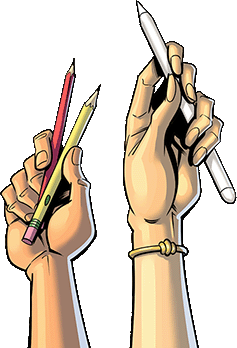6 Surprising Ways Comics and Graphic Novels Can Benefit English Language Learners
October 26, 2022
A well-designed graphic novel combines text and illustrations to tell a story. Graphic novels are typically longer than traditional comics and often explore more complex themes. Both are widely popular among English Language Learners (ELLs) of all age groups to help build their literacy skills.
A study from the Academic Center for Education, Culture, and Research revealed that using comic and graphic novel texts containing illustrations can be more efficient than teaching through regular texts. Explore six benefits of using comics and graphic novels to help ELLs strengthen their English language comprehension in the classroom.
Explores Universal Themes for Contextual Understanding
Contextual understanding is an essential skill ELL students can learn from reading comics and graphic novels. These stories often deal with a wide range of social issues in a way that is easy to relate to and engage with.
Many graphic novels are stories set in different periods concerning different cultures, which can help readers understand the story’s context. This can be an invaluable tool for students who are studying history or social studies. Whether a coming-of-age story or a tale of love and loss, these universal themes resonate with everyone.
Helps Explain the Meaning of Figurative Language
Figurative language is a crucial element of both comics and graphic novels. It includes metaphors, similes, and hyperbole, which convey symbolic meanings more concisely and effectively than literal language.
For English language learners, comics and graphic novels can provide a valuable opportunity to see figurative language in action and to learn how to use it themselves. It can be a great way to achieve a higher reading level and gain a deeper, more natural understanding of the English language that they can’t get from reading a textbook.
Familiarize Readers with Unfamiliar Cultural Elements
Cultural elements are the building blocks of society. They include things like slang, values, customs, and beliefs. For English language learners, these elements can be unfamiliar and confusing. Comics and graphic novels can help to make these cultural norms more familiar and understandable through visual literacy using illustrations.
A non-native English reader can learn about the similarities and differences among cultures by reading graphic novels and seeing cultural norms through a visual medium. Comics and graphic novels bridge different societies, helping people to connect and communicate with each other.
Emphasizes Punctuation and Sentence Structure
Punctuation and sentence structure can be challenging for English language learners. Comics and graphic novels are excellent resources for helping to learn grammar. Punctuation is usually easy to spot in comic strips since characters often speak in short, clear sentences that end in exclamation points and question marks.
The combination of punctuation and short sentence structure with a visual representation of the story’s plot can help ELLs understand how punctuation marks are used in everyday speech.
Reading a graphic novel can also be helpful in understanding sentence structure. In comics and graphic novels, words are often placed next to the images they describe. Students reading comics learn English by using a visual sequence of events punctuated with written text to understand the relationships between different elements in the story.

Encourages Vocabulary learning with Visual Context Clues
Vocabulary is one of the essential literacy skills that English Language Learners need to learn to improve their reading skills. The visual nature of comics helps ELLs establish a connection between the word and image. For example, if a comic character looks surprised, the accompanying dialogue might include a word such as “astonished.”
Raina Telgemeier, a famous cartoonist, promotes using comics to help new and struggling readers learn vocabulary. She suggests reading the words, then looking at the picture to piece together what the word means.
Some middle schools close ELL lessons with an activity in which words are deleted from a text, and students fill in the blanks. Comics are often used for close activities due to their rich visual art and helpful context clues for students to increase their literacy by determining the correct words.
Motivates Reading Through Investment in the Characters and Story
The storyline and character development make comics and graphic novels captivating for ELLs. When readers are invested in the characters, they want to see what happens next in the story. This motivation can help struggling readers stick with the subject matter.
Often, students can follow along with a well-crafted story even if they don’t feel motivated enough to continue reading. This makes comics and graphic novels excellent tools for building reading comprehension skills and keeping ELLs engaged in learning rather than mentally checking out of a lesson.
Teachers can provide students with a comic book one page at a time, and after they read each page, have them write down their predictions about what will happen next. Alternatively, students can share their predictions with a partner or in small groups.

Publish Your Graphic Novel or Comic with Comix Well Spring
Whether you’re a self-publishing teacher, graphic novel creator, or indie artist, Comix Well Spring can help you bring your work to life to support ELLs in the classroom or to enjoy at home. We offer professional printing services, including square bound comics or graphic novels, saddle stitched comic books", posters, and flyers.
Use our services to print a helpful ELL poster for your classroom of punctuation or vocabulary that ELLs can look for when reading graphic novels. You can also write and print your own comic to illustrate important English topics to help them learn.
We deliver best-in-class printing using high-tech and state-of-the-art equipment for a high-quality product.
Contact us today at (734) 927-0044 to learn more about our services and how we can help you publish your own graphic novel or comic.


